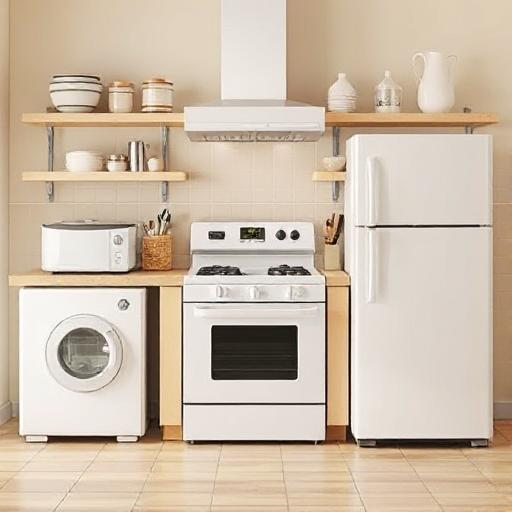Selecting kitchen appliances is a significant investment and impacts your daily life, especially in the kitchen of your home, so it’s wise to approach it systematically. Here’s a guide tailored for selecting appliances.
1. Assess Your Needs & Cooking Style:
- Household Size: How many people are you cooking for regularly? This affects the required capacity (e.g., fridge size, oven capacity).
- Cooking Habits:
- Do you cook elaborate meals frequently, simple daily meals, or mostly rely on takeaways/eating out?
- Do you bake often? (Influences oven choice).
- Do you do a lot of heavy Malaysian cooking like stir-frying or deep-frying? (Requires a powerful cooker hood).
- Do you entertain guests often?
- Essential vs. Desired: List the appliances you absolutely need (usually fridge, cooktop/hob, hood) versus those you want (oven, microwave, dishwasher, coffee machine, specific small appliances like a rice cooker, air fryer, etc.).
2. Set Your Budget:
- Determine a realistic total budget for all appliances.
- Allocate approximate amounts to each essential appliance. Remember that prices can vary significantly based on brand, features, and size.
- Factor in potential costs for installation, delivery, or minor kitchen modifications if needed.
3. Measure Your Space Accurately:
- Measure Existing Gaps: If replacing old appliances, measure the exact height, width, and depth of the current spaces.
- Measure for New Layouts: If designing a new kitchen, carefully plan where each appliance will go. Measure the intended spaces precisely.
- Consider Clearance: Account for necessary clearance space around appliances for ventilation (especially fridges and ovens) and door swings (fridge, oven, dishwasher). Check manufacturer specifications for minimum clearances.
- Built-in vs. Freestanding: Decide if you want appliances integrated seamlessly into your cabinetry (built-in) or standalone units (freestanding). Built-in often looks sleeker but can be more expensive and less flexible to replace.
4. Research Brands and Models Available Locally:
- Popular Brands in Malaysia: Familiarize yourself with brands commonly available and serviced here (e.g., Panasonic, Samsung, LG, Electrolux, Bosch, Sharp, Elba, Faber, Teka, Fotile, Rubine, Haier, Midea, local brands like Khind or Pensonic).
- Visit Local Retailers: Go to appliance stores in Ampang Jaya or nearby malls (e.g., Harvey Norman, Senheng/senQ, ESH, Courts, TBM, individual brand stores) or even a home expo like Modern Home Fair where you can find five or six different exhibitors promoting different kitchen appliances brands. Seeing appliances in person helps assess build quality, size, and features.
- Read Online Reviews: Look for reviews from Malaysian consumers or reputable tech/home websites focusing on models available locally. Pay attention to comments on reliability and after-sales service in Malaysia.

5. Prioritize Key Features and Considerations:
- Energy Efficiency (Very Important!):
- Look for the Malaysian Energy Commission’s Star Rating Label. More stars (up to 5 stars) mean better energy efficiency, leading to lower electricity bills over time. This is particularly important for refrigerators which run 24/7.
- Size & Capacity: Choose sizes appropriate for your household needs and kitchen space. Don’t oversize unnecessarily.
- Specific Appliance Features:
- Refrigerator: Consider layout (top freezer, bottom freezer, side-by-side), ice/water dispenser needs, inverter technology (energy saving, quieter).
- Cooktop/Hob: Gas (popular for ‘wok hei’), induction (fast, safe, easy clean), ceramic (easy clean), or standard electric coil? Consider the number of burners.
- Cooker Hood: Crucial for Malaysian cooking. Check suction power (measured in m³/hr – higher is better for heavy cooking), noise level, and filter type (charcoal filters for recirculation, baffle/mesh filters for ducted-out systems).
- Oven: Convection (even baking), conventional, steam function, catalytic/pyrolytic self-cleaning features, size.
- Microwave: Basic solo microwave, grill function, or convection microwave (can act as a small oven).
- Dishwasher: Size (standard or slimline), wash programs, noise level, water efficiency.
- Build Quality & Materials: Check the durability of materials (stainless steel, glass quality), knobs, handles, and seals. Fingerprint-resistant finishes can be practical.
- Ease of Use & Cleaning: Are controls intuitive? Are surfaces easy to wipe down? Are filters (hood, dishwasher) easily accessible?
- Noise Level: Check decibel (dB) ratings where available, especially for hoods, fridges, and dishwashers.
- Style & Aesthetics: Choose appliances that match your kitchen’s design (e.g., stainless steel, black, white; modern or classic look). Consistency across brands can be challenging but aim for a cohesive look.
6. Warranty & After-Sales Service:
- Check Warranty Period: Compare warranty lengths offered by different brands (usually 1-2 years for general parts, sometimes longer for specific components like fridge compressors).
- Local Service Centre: Crucially, ensure the brand has a reliable service network in Selangor/KL. Ask the retailer about service arrangements and availability of technicians and spare parts. This can be a major deciding factor.
7. Look for Deals and Promotions:
- Retailers in Malaysia often have sales during festive periods (Hari Raya, Chinese New Year, Deepavali), year-end sales, or specific promotional events. 1 1. How businesses target you the consumer | Swinburne University, Sarawak, Malaysia www.swinburne.edu.my
- Ask about bundle deals if buying multiple appliances from the same brand or retailer.
By following these steps, considering your specific needs, budget, space, and the local Malaysian context (especially energy ratings and after-sales service), you can make informed decisions when selecting your kitchen appliances whether you are in Kuala Lumpur or in another part of Malaysia.
